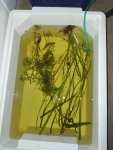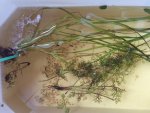Scintillation
New member
- Joined
- May 31, 2016
- Messages
- 4
- Reaction score
- 0
- Points
- 0
- Location
- Sydney, Australia
- Country
- Australia
Hi Caudata.org!
What should I expect when I open the lid to my (temporary) enclosure? If I was asked that question yesterday, I certainly wouldn't have answered "Around 70 small, dark dots splattered around the place" but lo and behold, today that is my answer.
I'm terrified.
I acquired these axies (leuc male, wild female) around 2 weeks ago (a rush thing, had to set up my tank, now waiting for it to cycle) so I plopped them in a 55 litre plastic tank for "holding". I thought the small-ish space might stave off any breeding until they got into the larger tank!
What do I do? The website is only letting me attach one picture (the eggs aren't on any plants; just some ornaments and maybe there are some on a log) -should I take the eggs out or the parents out?? I have a couple of aquatic plants I can shove into the tank for added ammonia/nitrate-consumption and another similar plastic tank-ish thing.
I didn't separate the two axies when I first got them because according to the previous owners "They never had any babies" and they were feeding them circa once a week, even during warmer seasons... So I thought the female wouldn't have had enough resources to make eggs. And because I had only one filter -the one that came with them... *Internal screaming*.
Any advice is helpful. Thank you for taking the time!!
What should I expect when I open the lid to my (temporary) enclosure? If I was asked that question yesterday, I certainly wouldn't have answered "Around 70 small, dark dots splattered around the place" but lo and behold, today that is my answer.
I'm terrified.
I acquired these axies (leuc male, wild female) around 2 weeks ago (a rush thing, had to set up my tank, now waiting for it to cycle) so I plopped them in a 55 litre plastic tank for "holding". I thought the small-ish space might stave off any breeding until they got into the larger tank!
What do I do? The website is only letting me attach one picture (the eggs aren't on any plants; just some ornaments and maybe there are some on a log) -should I take the eggs out or the parents out?? I have a couple of aquatic plants I can shove into the tank for added ammonia/nitrate-consumption and another similar plastic tank-ish thing.
I didn't separate the two axies when I first got them because according to the previous owners "They never had any babies" and they were feeding them circa once a week, even during warmer seasons... So I thought the female wouldn't have had enough resources to make eggs. And because I had only one filter -the one that came with them... *Internal screaming*.
Any advice is helpful. Thank you for taking the time!!



